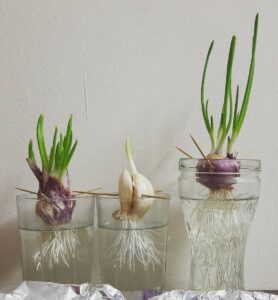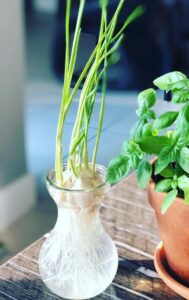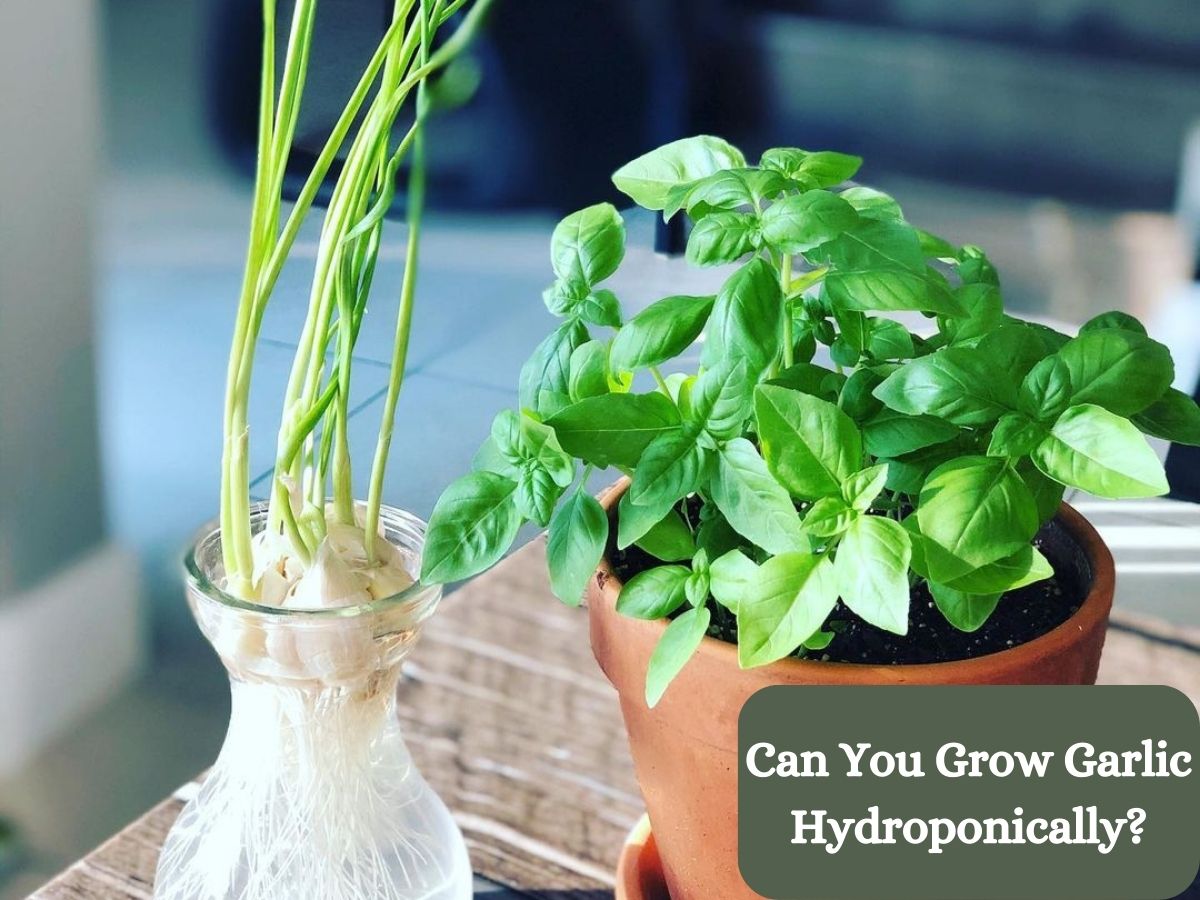Can you grow garlic hydroponically and enjoy a bountiful harvest of those aromatic bulbs without traditional soil? You bet! Hydroponic gardening has opened up a world of possibilities for growing various plants, and garlic is no exception. If you’re a gardening enthusiast looking to explore new ways to cultivate this flavorful herb, you’re in for a treat!
Imagine, healthy garlic cloves sprouting in a controlled, nutrient-rich environment, receiving just the right amount of light and care to thrive. With the right techniques, you can achieve impressive yields of this versatile kitchen staple.
In this blog, we’ll delve into the exciting realm of hydroponic garlic cultivation. From selecting the best garlic varieties to setting up your hydroponic system and caring for your plants, we’ve got you covered. Whether you’re a seasoned hydroponic gardener or just starting, this comprehensive guide will walk you through everything you need to know about growing garlic hydroponically.
So, roll up your sleeves and get ready to embark on a rewarding journey of growing delicious garlic bulbs, all without getting your hands dirty.
Can You Grow Garlic Hydroponically?
Yes, garlic can be grown hydroponically, and it’s an excellent option for those who want to enjoy fresh garlic year-round or in locations where traditional soil-based gardening is not feasible. Growing garlic hydroponically allows you to control the growing conditions more precisely, which can lead to faster growth, higher yields, and better-quality garlic.
One of the main benefits of hydroponic gardening is that it requires less space than traditional soil-based gardening. In addition, hydroponic systems use water more efficiently, which reduces water usage by up to 90%. This is especially important in areas with water shortages or droughts.
Another significant advantage of growing garlic hydroponically is that it reduces the risk of soil-borne diseases and pests. With hydroponic gardening, you don’t need to worry about soil-borne pests, such as nematodes, which can damage garlic roots and reduce yields. Furthermore, hydroponic gardening eliminates the need for chemical fertilizers, which can harm the environment and contaminate the soil.
Lastly, hydroponic gardening allows you to grow garlic year-round, regardless of the weather outside. With the right hydroponic system and environmental conditions, you can enjoy fresh, high-quality garlic whenever you want.
Overall, growing garlic hydroponically offers numerous benefits and is a great option for those who want to enjoy fresh garlic without the hassle and limitations of traditional soil-based gardening. Check here to know if you can grow some of your favorite root vegetables.
Planting Garlic Hydroponically
Preparing Garlic Cloves
When it comes to planting garlic hydroponically, starting with high-quality garlic cloves is essential for a successful harvest. Follow these steps to ensure you’re working with the best cloves for your hydroponic setup:
- Selecting Quality Garlic Cloves for Planting: Choose large, firm garlic bulbs with no signs of damage or disease. If possible, opt for certified disease-free garlic cloves to minimize the risk of introducing pathogens into your hydroponic system. It’s better to purchase garlic cloves from reputable nurseries or specialized seed suppliers, as the quality is generally higher than the garlic you find at the grocery store.
- How to Properly Handle and Treat Garlic Cloves Before Planting: Handle garlic cloves with care to avoid bruising or damaging them. The goal is to keep the cloves intact and prevent any injuries that might affect their growth.
Before planting, you have the option to pre-treat your garlic cloves to promote healthy root development and protect against potential diseases. One common pre-treatment method is to soak the cloves in a solution of water and a natural fungicide, such as a 1% hydrogen peroxide solution. This can help reduce the risk of fungal infections during the early stages of growth.
Planting Garlic in the Hydroponic System
Now that you have your quality garlic cloves prepared, it’s time to plant them in your hydroponic system. Follow these guidelines to give your garlic the best start:
- Spacing and Depth Considerations for Garlic Cloves: In hydroponic systems, garlic cloves should be spaced appropriately to allow for healthy growth without crowding. For most garlic varieties, aim for a spacing of about 4 to 6 inches (10 to 15 cm) between cloves. This spacing ensures enough room for the plants to develop and access nutrients without competing with neighboring garlic.
- Regarding depth, plant the garlic cloves with their pointed ends facing upward and their flat ends down. The cloves should be partially buried in the hydroponic medium, leaving the tips exposed above the surface. A good rule of thumb is to plant the cloves about 2 inches (5 cm) deep. This depth provides stability while still allowing the shoots to emerge freely.
- Planting Techniques for Optimal Growth: In a nutrient film technique (NFT) system, insert the prepared garlic cloves into the pre-made holes or growing channels, making sure they are secure in the hydroponic medium. If you are using another type of hydroponic system, adjust the planting method accordingly.
- After planting, give your garlic cloves a thorough watering to settle the growing medium and promote contact between the cloves and the medium. Ensure that the hydroponic system provides a continuous flow of nutrient solutions to meet the plants’ needs as they grow.
Maintain a consistent environment for your hydroponic garlic by monitoring light, temperature, and nutrient levels. Be patient, as garlic is a slow-growing crop. With time and proper care, you’ll soon see the garlic cloves sprout and transform into healthy plants.
Planting garlic hydroponically is a rewarding and efficient way to grow this versatile and flavorful herb. By selecting quality garlic cloves and providing the right conditions in your hydroponic system, you’ll be well on your way to a bountiful harvest. Remember to space the cloves properly, plant them at the correct depth, and give your garlic the care and attention it deserves as it grows. Enjoy the process of nurturing your hydroponic garlic and look forward to harvesting your homegrown, flavorful bulbs in due time. Happy gardening!
(Note: The information provided in this article is based on general guidelines for growing garlic hydroponically. For specific varieties and local conditions, it’s advisable to consult local experts or horticulturists.)

Steps to Grow Garlic Hydroponically
To grow garlic hydroponically, you’ll need the following materials:
- Garlic bulbs
- Net cups or other plant containers
- Hydroponic system (deep-water culture or nutrient film technique)
- Nutrient-rich water
- Growing medium (such as Rockwool or perlite)
- pH test kit
- Thermometer
- Light source
Now, let’s go over the steps involved in growing garlic hydroponically:
- Choose the right garlic variety: Select a garlic variety that is well-suited to hydroponic growing, such as hard-neck garlic. Softneck garlic can also be grown hydroponically, but it requires cooler temperatures to produce larger bulbs. Here is a detailed guide on how to start a seed in hydroponics.
- Preparing the hydroponic system: Set up the hydroponic system and fill it with nutrient-rich water. Ensure that the system is properly aerated and that the water temperature is maintained between 60°F to 75°F. Test the pH level of the water using a pH test kit and adjust it between 5.5 to 6.5.
- Planting garlic bulbs in the hydroponic system: Place the garlic bulbs into the net cups or plant containers filled with a growing medium, such as rock wool or perlite. Make sure the bulbs are not completely covered by the growing medium and are only partially exposed to the nutrient solution.
- Maintaining the hydroponic system: Monitor the hydroponic system regularly to ensure the garlic plants receive proper care. Maintain the water pH level between 5.5 and 6.5 and ensure the nutrient solution is properly oxygenated. Provide the plants with adequate light exposure and maintain the water temperature between 60°F to 75°F.
- Harvesting garlic from the hydroponic system: After 6-8 months of growth, the garlic bulbs will be ready for harvest. The bulbs should be firm and fully developed. Gently remove the bulbs from the hydroponic system and allow them to dry for several days in a cool, dry, and well-ventilated area.
By following these steps, you can grow fresh and flavorful garlic hydroponically all year round!
How to harvest garlic grown hydroponically
Harvesting garlic grown hydroponically is similar to harvesting garlic grown in soil. Here are the steps:
- Wait for the garlic to mature: Garlic typically takes around 6-8 months to mature, depending on the variety and growing conditions. When the garlic leaves start to turn yellow and die back, it’s a sign that the bulbs are nearly mature.
- Check the bulbs: When the garlic leaves have died back, carefully remove the bulbs from the hydroponic system. Check the bulbs to make sure they are firm and fully developed.
- Dry the garlic: To prepare the garlic for storage, it’s important to dry it first. You can do this by hanging the garlic bulbs in a cool, dry, and well-ventilated area for several days until the outer layers of the garlic have dried out. Once the garlic is dry, gently remove any remaining dirt or debris.
- Store the garlic: Store the garlic in a cool, dark, and dry place. Properly cured garlic can last for several months or even up to a year.
With these simple steps, you can easily harvest and store garlic grown hydroponically for delicious and flavorful meals all year round.
Can hydroponic garlic be as flavorful as soil-grown garlic?
Yes, hydroponic garlic can be just as flavorful as soil-grown garlic, and in some cases, even more so.
In hydroponic gardening, the grower has complete control over the nutrient solution and growing conditions, which can result in optimal plant growth and flavor development. Additionally, hydroponically grown garlic is less susceptible to soil-borne diseases and pests, which can negatively affect flavor.
However, the flavor of hydroponic garlic may be affected by the specific hydroponic system used and the variety of garlic grown. Some garlic varieties may be better suited to hydroponic growing than others, and using certain nutrients and growing mediums may also affect flavor.
Ultimately, whether hydroponic garlic is as flavorful as soil-grown garlic depends on the growing conditions and the gardener’s skill. Hydroponic garlic can be just as delicious and flavorful with proper care and attention as garlic is grown in soil.
Issues that can arise when growing garlic hydroponically
While hydroponic garlic growing can be a rewarding experience, some common issues can arise when growing garlic hydroponically. Here are a few examples:
- Over or under-watering: Garlic plants require a precise balance of water and nutrients to grow properly. Over or under-watering can result in stunted growth, wilted leaves, and poor bulb development.
- Nutrient imbalances: The nutrient solution used in hydroponic growing must be properly balanced to support garlic growth. An imbalance of nutrients can lead to poor plant growth, weak bulbs, or even plant death.
- Pest and disease problems: Although hydroponic growing reduces the risk of soil-borne pests and diseases, garlic plants can still be susceptible to other issues, such as spider mites, aphids, and fungal diseases.
- Inadequate lighting: Garlic plants require adequate light to grow and produce healthy bulbs. Insufficient lighting can lead to weak plants, small bulbs, and poor flavor.
- Temperature fluctuations: Garlic plants prefer a cooler growing environment, and temperature fluctuations outside of their ideal range can impact growth and bulb development.
By being aware of these common issues and taking proactive measures to prevent and address them, hydroponic garlic growers can enjoy a bountiful harvest of healthy, flavorful garlic.
Solutions
Sure, here are some ways to solve the common issues that can arise when growing garlic hydroponically:
- Over or under-watering: Monitor the water levels in the hydroponic system regularly and adjust as needed to maintain a consistent level of moisture. Avoid over-fertilizing, which can lead to over-watering and root rot.
- Nutrient imbalances: Use a high-quality nutrient solution specifically formulated for garlic and ensure it is mixed according to the manufacturer’s instructions. Monitor the pH levels of the nutrient solution regularly and adjust as needed to maintain a balanced pH level.
- Pest and disease problems: Practice good hygiene by keeping the hydroponic system clean and avoiding introducing pests or diseases to the growing environment. Consider using natural pest control methods, such as introducing beneficial insects or using organic insecticides.
- Inadequate lighting: Provide adequate lighting for the garlic plants by using high-quality grow lights and ensuring they are positioned at the proper distance from the plants. Monitor the light levels regularly and adjust as needed to ensure the plants are receiving the optimal amount of light.
- Temperature fluctuations: Use a thermometer to monitor the temperature in the hydroponic system and adjust as needed to maintain a consistent temperature range. Consider using a cooling system or insulation to help regulate the temperature in the growing environment.
By taking these proactive measures, hydroponic garlic growers can prevent or address common issues that can arise when growing garlic hydroponically and enjoy a successful harvest of healthy and flavorful garlic.

Can You Grow Garlic Hydroponically FAQs?
How long does it take to grow garlic hydroponically?
Growing garlic hydroponically is a patient gardener’s delight, as it requires a longer growth cycle compared to some other crops. On average, hydroponic garlic takes around 7 to 9 months to reach maturity from the time of planting.
This duration includes the time for sprouting, vegetative growth, bulb development, and the curing process. While the wait may seem long, the flavorful and nutrient-rich garlic bulbs you’ll harvest at the end of the journey will undoubtedly make it worthwhile.
What kind of garlic is best for hydroponic gardening?
For successful hydroponic garlic cultivation, choosing the right garlic variety is crucial. Both softneck and hard-neck garlic varieties can be grown hydroponically, but hard-neck varieties are generally preferred.
Hardneck garlic tends to perform better in indoor environments and has a shorter growing cycle compared to softneck garlic. Varieties like “German Extra Hardy” and “Spanish Roja” are excellent choices for hydroponic garlic due to their adaptability to controlled conditions and remarkable flavor.
What are the ideal growing conditions for hydroponic garlic?
To ensure your hydroponic garlic thrives, it’s essential to create optimal growing conditions. Here are the key factors to consider:
- Light: Provide your garlic plants with 12 to 16 hours of full-spectrum LED grow lights each day to mimic natural sunlight and support robust growth.
- Temperature: Maintain a moderate temperature range between 60°F to 77°F (15°C to 25°C) throughout the growing period. Avoid extreme fluctuations in temperature to prevent stress on the plants.
- Nutrients: Hydroponic garlic relies on nutrient-rich solutions for its growth. Ensure your nutrient solution contains essential elements like nitrogen, phosphorus, potassium, and micronutrients in balanced proportions.
- pH Levels: Maintain a slightly acidic to neutral pH range of 6.0 to 7.0 in your hydroponic system for optimal nutrient absorption and healthy plant development.
Is hydroponic garlic more expensive than soil-grown garlic?
The cost of hydroponic garlic can vary depending on several factors, such as the initial setup cost of the hydroponic system, the quality of the growing medium and nutrient solutions used, and the price of electricity for providing artificial lighting.
Initially, hydroponic garlic may have a higher setup cost compared to traditional soil-grown garlic due to the equipment and materials required. However, once the hydroponic system is set up, subsequent costs can be reduced by reusing some materials and efficiently managing resources.
The benefits of hydroponic gardening, such as higher yields in controlled environments and reduced space requirements, can make it a cost-effective choice in the long run. Additionally, the satisfaction of growing your garlic year-round, free from soil-borne diseases and pesticides, can be priceless for gardening enthusiasts.
Conclusion
Growing garlic hydroponically is a viable and rewarding option for those who are interested in gardening. Hydroponic garlic cultivation offers many benefits over traditional soil-based gardening, such as greater control over growing conditions, higher yields, and reduced risk of soil-borne diseases and pests.
To grow garlic hydroponically, follow the steps outlined in this article, and be aware of common issues that can arise, such as over or under-watering, nutrient imbalances, pest and disease problems, inadequate lighting, and temperature fluctuations. By taking proactive measures to prevent and address these issues, you can enjoy a successful harvest of healthy and flavorful garlic.
Overall, we encourage readers to try growing garlic hydroponically and explore the many benefits of this innovative gardening method. With proper care and attention, you can grow delicious and healthy garlic right in your own home.
